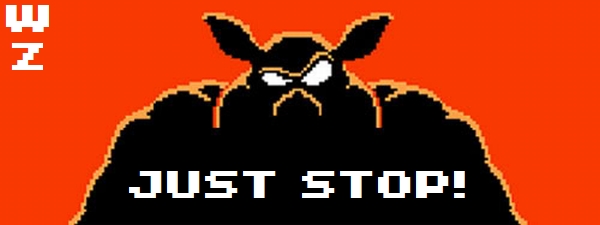
When the Internet decides to collectively believe something that’s just not true, we have to cry out… Just Stop! This is what’s making a Warp Zoned editor rip his computer from the wall in frustration today…
With a generational shift looming for all three console manufacturers, a lot of digital ink has been spilled over the price of games and the belief that… SOMETHING. MUST. BE. DONE. Because didn’t you hear? Games are more expensive now than they’ve ever been. It’s true. I read it on the Internet.
No! Just Stop! YOU. ARE. WRONG.
Not only are the games being produced in 2012 priced similarly to games that were released in decades gone by, many of them are cheaper. That’s right, cheaper. And no, I’m not some stooge being paid by the publishers to peddle this theory, it’s the truth. Why, I remember it just like it was yesterday… [insert wavy lines here]
I think it’s safe to consider $59.99 the price of an average game in 2012. This price point has become the default for nearly every major PS3 and Xbox 360 release. However, Nintendo still publishes all of their Wii titles at $49.99 or lower (and third parties have followed suit). And occasionally you’ll see a publisher launch a PS3/Xbox 360 game at $39.99 (one of my favorites from last year, Earth Defense Force: Insect Armageddon, instantly springs to mind). So while $59.99 is the most common price for new games, it’s by no means the cheapest.
But then what about games published through Xbox Live Arcade, PlayStation Network, and WiiWare? Are these not “real” games? And aren’t all of them sold for between $5 and $20? Doesn’t that mean gaming is cheaper than it’s ever been? After all, these download services have received games like Mega Man 9 and Sonic the Hedgehog 4 in recent years. These are direct sequels to games that we can all agree were “real” on the NES and Genesis. Yet, I paid $50 for Mega Man 6 back in 1994, and only $10 for Mega Man 9 in 2008.
Don’t believe me? Look at this Electronics Boutique catalog from 1993:
Some of the prices shown in that catalog would singe the hair off a console gamer today. Mortal Kombat was $64. Super Mario All-Stars was $65. Street Fighter II Turbo was $74. WWF Royal Rumble was $75. And these games weren’t anomalies. Every other title in that catalog is priced between $40 and $60. JUST. LIKE. TODAY. And remember, these aren’t inflation-adjusted prices. They’re what actual gamers paid for actual games with actual money in 1993.
“But,” you say, “those prices were as high as they were because those games were released on cartridges.” Ah, this is true. Cartridge-based games cost more to mass produce than disc-based games (Robert Grant’s “Rivalry in Video Games” study lists a production cost of $1.50 for a PSone disc versus $12 for an N64 cartridge).
But what about the production budget of games in 1993 versus games today? The big blockbusters of 1993 cost just a fraction of the tens of millions of dollars it takes to produce a video game in 2012. Looking at Grant’s study again, the average blockbuster game in the early 90s required a budget of only $300,000. So while games are cheaper to mass produce in 2012, they are much, MUCH more expensive to develop.
And believe it or not, the game industry does a better job of keeping prices the same from year to year than any other medium.
Box Office Mojo has statistics on the average movie ticket price for every year going back to 1939 (it was $0.23, by the way). But let’s use our 1993 to 2012 comparison again. In that 20-year span, the average movie ticket jumped from $4.14 to $7.83. That’s an 89% increase.
Or what about music? If you want to say, “prices for music have been falling for several years now,” you’d be right. What you might not know is that the music industry was forced to pay restitution to music buyers in 2002 for illegally fixing the price of compact discs throughout the 90s. So the only reason you’re paying under $20 for a music CD (or iTunes download) in 2012 is because Uncle Sam bullied the music industry bullies.
Only books can claim to carry a similar price in 2012 as they did in the early 90s. Average pricing information for the book publishing industry is hard to come by, so I went to my own bookshelf. I own a paperback copy of The Stand from 1991 with a cover price of $8.50. That same novel is currently being sold in paperback for $8.99, an increase of only 49 cents.
So what have we learned today? First of all, games are NOT more expensive today than they’ve ever been. In fact, between each console’s download service and a few budget publishers, it could be said that video games are cheaper than ever before. Thinking about production costs again, you could say we’re lucky that gamemakers haven’t decided to raise the price on us any more. We paid $70 a game before, you don’t think we’d pay it again?
So… just… stop!







